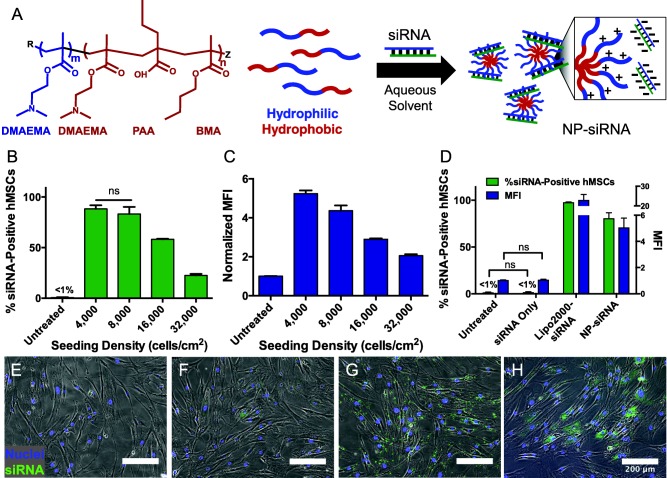Figure 1.

Diblock copolymers self‐assemble into nanoparticles (NP). NP uptake and subsequent gene silencing is a function of hMSC seeding density 24 and 48 hr post‐treatment, respectively. (A) Schematic shows diblock copolymer structure, diblock self‐assembly, and complexation with siRNA. R and Z are functional end groups. m = 71, n = 138. Abbreviations: DMAEMA = dimethylaminoethyl methacrylate, PAA = propylacrylic acid, BMA = butyl methacrylate. hMSCs were seeded at varying densities and incubated with 30 nM NP‐siRNA complexes. (B) Flow cytometry reveals that a 30 nM dose of fluorescently labeled NP‐siRNA results in significantly greater uptake at lower seeding densities. (C) Relative quantification of the median fluorescent intensity (MFI) of treated cells indicates that the relative amount of NP‐siRNA taken up by cells increases as seeding density decreases. (D) Lipofectamine2000 was used to deliver siRNA as a positive control (Lipo2000‐siRNA) to hMSCs seeded at 8,000 cells/cm2. Flow cytometry analysis shows Lipo2000‐siRNA resulted in more siRNA‐positive hMSCs and greater MFI compared to NP‐siRNA. All pairwise comparisons are significant (p < .01) unless labeled ns (not significant). Significance was determined using one‐way ANOVA with Tukey's test for multiple comparisons. (E–H) Representative multichannel fluorescence‐phase microscopy corroborates successful NP‐siRNA uptake in hMSCs seeded at 8,000 cells/cm2 (H) compared to untreated (E) and siRNA only controls (F). Furthermore, NP‐mediated siRNA delivery results in diffuse siRNA signal throughout the cytoplasm compared to the punctate, confined siRNA signal observed in cells treated with Lipofectamine2000 (G). Scale bar = 200 μm. Error bars represent the standard deviation
